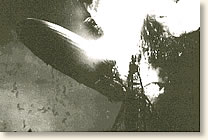|

The Hindenburg bursts into flames
May 6, 1937
|
The giant airship, Hindenburg, made history with her first transatlantic flight in May of 1936. The 804-foot long, hydrogen-filled behemoth moved through the air powered by four 1,050hp engines. She had a top speed of 82 mph and a range in excess of 8,000 miles. Luxury surrounded her 70 passengers. Amenities included a dining room, cocktail lounge, a library and a sitting room equipped with a grand piano. During the 60 hour flight from Frankfurt am Main, Germany to Lakehurst, New Jersey passengers entertained themselves with long walks along promenades bordered by large windows.
The 1936 season was a great success as the Hindenburg carried over 1,300 passengers and thousands of pounds of cargo across the Atlantic. The future of the giant zeppelin looked bright. The high hopes for the 1937 season perished when the airship crashed in flames at the end of her maiden voyage of the year. As the Hindenburg maneuvered to land, something ignited her load of volatile hydrogen. Within seconds flames engulfed the entire ship as passengers and crew leapt for their lives. Thirty-five aboard the ship and one member of the ground crew died. The cause of the fire remains a mystery but its effect marked the end of the commercial use of airships.
Radio reporter Herbert Morrison, sent to cover the airship's arrival, watched in horror. His eye witness description of the disaster was the first coast-to-coast radio broadcast and has become a classic piece of audio history.
References: Deighton, Len, and Schwartman, Arnold, Airshipwreck (1979); Mooney, Michael, M. The Hindenburg (1972).
|






